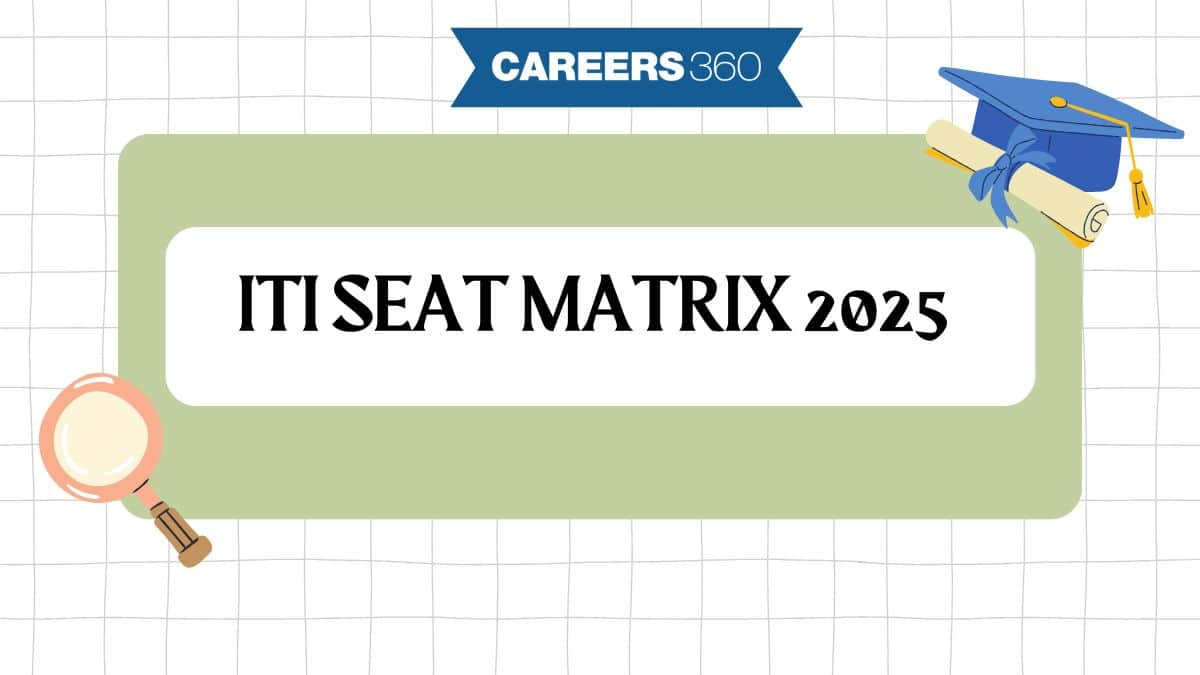ITI Seat Matrix 2025: State-Wise, Trade-Wise ITI Seats, Reservation
ITI Seat Matrix 2025: Candidates can check the complete ITI 2025 seat matrix list on this page. The seat matrix for ITI 2025 will provide details about the various Industrial Training Institutes across India. The seat matrix will help students understand the courses which will be available for application. Candidates can also check the admission process and how the seats are distributed among different institutions. The seat matrix will be released as part of the admission for ITI courses. Candidates are advised to check the seat matrix to understand the distribution of seats in the ITI program of their choice. Students who will be short-established will be allotted seats based on rank.

What is the ITI Seat Matrix?
The Seat Matrix is the allocation of vacant seats in the various vocational trades in various ITIs. It will contain information like how many seats to be given to different categories of students (general, reserved and special categories), specific trades as well as different levels of training (such as NCVT or SCVT courses). The seat matrix makes the process of admission transparent, fair and on the basis of eligibility criteria, which makes the management of the intake process easy on the part of students and institutions concerned.
ITI 2025 Seat Matrix PDF Download Link
Events | Download PDF link |
Andhra Pradesh ITI 2025 seat matrix | |
Arunachal Pradesh ITI 2025 seat matrix | To be notified |
Assam ITI Seat Matrix 2025 | |
Bihar ITI Seat Matrix 2025 | |
Chandigarh ITI Seat Matrix 2025 | To be notified |
Chhattisgarh ITI Seat Matrix 2025 | |
Dadra & Nagar Haveli and Daman & Diu ITI Seat Matrix 2025 | To be notified |
Delhi ITI Seat Matrix 2025 | |
Goa ITI Seat Matrix 2025 | |
Gujarat ITI Seat Matrix 2025 | |
Haryana ITI Seat Matrix 2025 | |
Himachal Pradesh ITI Seat Matrix 2025 | To be notified |
Jammu and Kashmir ITI Seat Matrix 2025 | To be notified |
Jharkhand ITI Seat Matrix 2025 | |
Karnataka ITI Seat Matrix 2025 | |
Kerala ITI Seat Matrix 2025 | |
Lakshadweep ITI Seat Matrix 2025 | To be notified |
Madhya Pradesh ITI Seat Matrix 2025 | |
Maharashtra ITI Seat Matrix 2025 | |
Manipur ITI Seat Matrix 2025 | |
Odisha ITI Seat Matrix 2025 | To be notified |
Pondicherry ITI Seat Matrix 2025 | To be notified |
Punjab ITI Seat Matrix 2025 | To be notified |
Rajasthan ITI Seat Matrix 2025 | To be notified |
Tamil Nadu ITI Seat Matrix 2025 | |
TS ITI Seat Matrix 2025 | |
Tripura ITI Seat Matrix 2025 | |
Uttar Pradesh ITI Seat Matrix 2025 | |
Uttarakhand ITI Seat Matrix 2025 | |
West Bengal ITI Seat Matrix 2025 | To be notified |
Structure of ITI 2025 Seat Matrix
The ITI seat matrix 2025 includes the following detail
Total Number of Seats: This is the total amount of seats that any trade can have in a given ITI
Trade Details: The vocational trades offered at the institute say Electrician, Mechanic, Fitter, Carpenter, Welder etc.
Category-wise Distribution: A distribution of seats on the basis of category i.e. General, OBC (Other Backward Classes), SC (Scheduled Caste), ST (Scheduled Tribe), and EWS (Economically Weaker Sections).
Reservation Policy: The proportion of seats that have been reserved on the basis of different categories in accordance with government guidelines.
Duration of Courses: Detail about the length of each course that may be between 1 and 2 years.
Eligibility Criteria: Academic qualifications required for different trades (e.g., minimum educational qualifications, age limits, etc.).
Institute-wise Distribution: It is a comprehensive list of seats available in each trade provided by individual ITIs in different states or regions.
Frequently Asked Questions (FAQs)
Candidates can check the ITI seat matrix 2025 on this page.
Yes, the seat matrix can be different for government and private IITs in terms of reservation policies and the overall number of seats available.
ITI seat allotment will be based on the merit list of candidates with qualifying marks
No, the ITI seat matrix will not be changed in further counselling rounds.
Not all states release an ITI format seat matrix for Industrial Training Industries.
